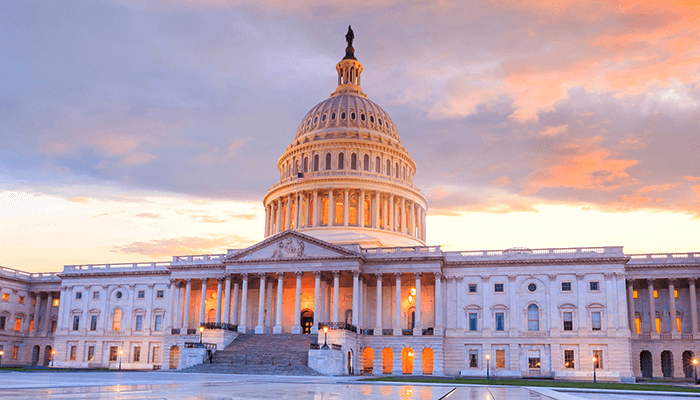Senate HELP Committee Proposes $355 Billion in Offsets
Yesterday, the Senate Health, Education, Labor, and Pensions (HELP) Committee released its part of the Senate reconciliation package, which we estimate will save roughly $355 billion between fiscal year (FY) 2025 and 2034.
The package includes a comprehensive reform of higher education financing that shares many similarities – and some significant differences – with the House Education and Workforce (E&W) Committee version passed by the House as part of the One Big Beautiful Bill Act (OBBBA). We estimate it would save about $30 billion less than the House version.
Specifically, the HELP bill modifies current income-driven repayment programs and simplifies repayment options, limits graduate and parent borrowing, creates modest new accountability provisions for schools, funds the Pell shortfall for one year (without making significant eligibility changes to the program), and limits future administrations from unilaterally cancelling student debt. Beyond the education changes, the bill also directly funds the Affordable Care Act (ACA) cost-sharing reduction subsidies, which end up lowering federal spending by reducing the premiums charged by ACA insurance plans.
Major differences between the House bill include the treatment of existing borrowers in repayment, not eliminating Subsidized Stafford loans, not changing Pell eligibility to plug the shortfall, a different accountability proposal, and fewer changes to parent loans.
Senate Reconciliation HELP Savings
| Policy | Cost(-)/Savings, FY 2025-2034 (billions) | |
|---|---|---|
| House E&W | Senate HELP | |
| Simplify and reform loan repayment | $295 | $270* |
| Limit borrowing for graduate students and by enrollment intensity | $50 | $50* |
| Prevent Presidents from unilaterally enacting debt cancellation | $32 | $32 |
| Eliminate in-school interest forgiveness | $20 | N/A |
| Repeal loan discharge authority | $16 | $16 |
| Modify Pell eligibility | $8 | N/A |
| Create new accountability rules | $6 | $3* |
| Repeal for-profit accountability rules | -$7 | N/A |
| Fund Pell Shortfall and create Workforce Pell | -$11 | -$11 |
| Restrict parent borrowing and increase undergraduate limits | -$19 | N/A |
| Interactions | -$41 | -$40* |
| Total Education Provisions | $349 | $320* |
| Fund Appropriations for ACA Cost Sharing Reductions | $34 (E&C) | $34 |
| Total, All Major HELP Provisions | $383 | $355 |
Sources: Committee for a Responsible Federal Budget, Congressional Budget Office, Office of Management and Budget, Department of Education, Institute for Education Sciences.
Note: Estimates may not add due to rounding
*Rough estimate provided by Committee for a Responsible Federal Budget.
The Senate HELP Committee proposals are in many ways similar to the House E&W Committee proposal, which we explain in detail here.
As with the House version, most of the savings – $270 billion by our estimate – come from modifying the terms of repayment. This includes repealing President Biden’s SAVE Income-Driven Repayment (IDR) plan, which is currently on pause by the courts. New borrowers would either enroll in a fixed plan or an income-driven plan, which has new benefits like, forgiving unpaid accrued interest per month, but a longer time until full forgiveness. The Senate largely retains the current structure of Income-Based Repayment (IBR) for existing borrowers (10 percent of discretionary income for 20 years for new borrowers as of 2014) – which differs from the House bill proposal that would raise payments to 15 percent of discretionary income for all borrowers and extended forgiveness to 25 years for graduate students.
We estimate an additional $50 billion of savings from eliminating graduate PLUS loans and limiting borrowing in other loans. Specifically, the package limits graduate borrowing to $20,500 annually and $100,000 total for master’s students and $50,000 annually and $200,000 total for professional students (such as lawyers, doctors, or dentists). This differs from the House, which had $150,000 aggregate caps for professional students, and annual limits in the House bill were set at the program level.
The Senate also sets an aggregate cap on the amounts parents can borrow to $20,000 per year and $65,000 lifetime per child, whereas the House plan caps aggregate borrowing to $50,000 for all children of the parent. The Senate also leaves loan limits for undergraduates untouched (whereas the House allows for borrowing based on the typical cost of a given program of study) and does not include the House requirement that students borrow before parents. The Senate also retains Subsidized Stafford loans, which are repealed in the House for a savings of $20 billion.
As with the House bill, the Senate limits the executive branch’s ability to make changes to the loan program, including attempts to modify repayment plans and cancel debt. CBO estimates this would save $32 billion through 2034.
The Senate also includes measures to improve school accountability, although these differ significantly from those in the House. The Senate uses a pure earnings test that excludes some types of programs. Schools that fail the earnings test (irrespective of how much students borrow) lose access to federal student loans for their students. The House bill creates a system of carrots and sticks where schools pay back a portion of students’ unpaid debt. The Senate and House also differ on which existing accountability provisions to repeal. The total accountability packages from the House and Senate are likely to be between $15 and $20 billion.
Similarly, like the House, the Senate appropriates $11 billion to reduce this year’s Pell shortfall and increase Pell spending through “workforce Pell.” Whereas the House includes various Pell reforms to generate the $11 billion of mandatory funding and close much of the $60 to $100 billion shortfall, the Senate package kicks the can on this issue.
Outside of education, the HELP Committee would appropriate funds to directly finance Cost-Sharing Reduction (CSR) subsidies within Affordable Care Act (ACA) insurance plans that do not generally cover abortion costs. This policy – which was proposed by the House through the Energy & Commerce Committee – has the effect of lowering premiums and thus reducing premium subsidies. On net, it would save the federal government about $35 billion.
Overall, we estimate the Senate HELP package would save around $355 billion, whereas comparable House policies would save $385 billion.
Both represent important improvements that would generate substantial federal savings, put downward pressure on higher education costs, and take important steps to rationalize the student loan program. Policymakers should take the best policies from both packages. In particular, the Senate should follow the House’s lead in having existing students repay their loans as well as making progress toward closing the massive Pell shortfall.
More importantly, these reforms should be used to reduce the debt or, at a minimum, as part of a budget-neutral package. Congress should not add $3 trillion to $7 trillion to the national debt.


